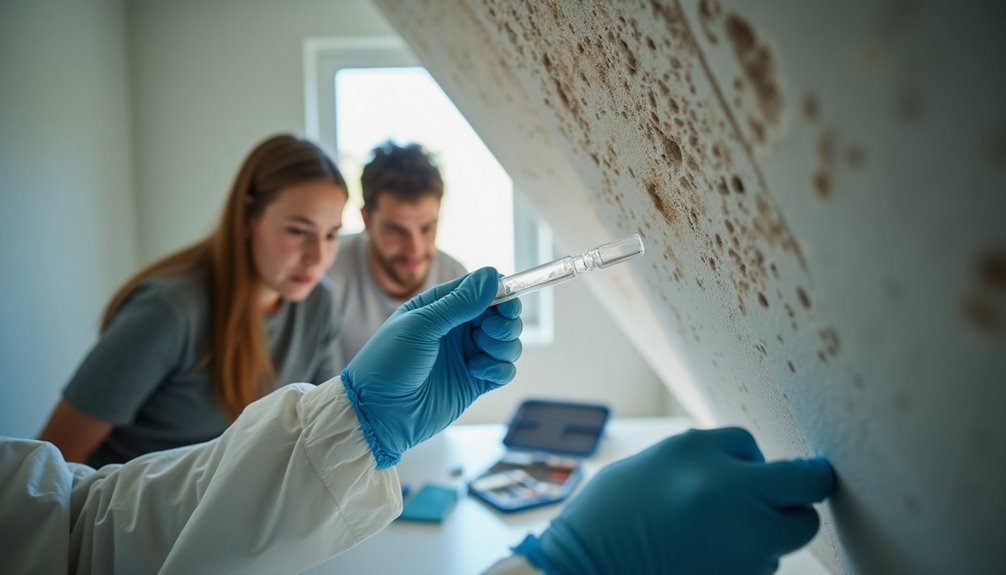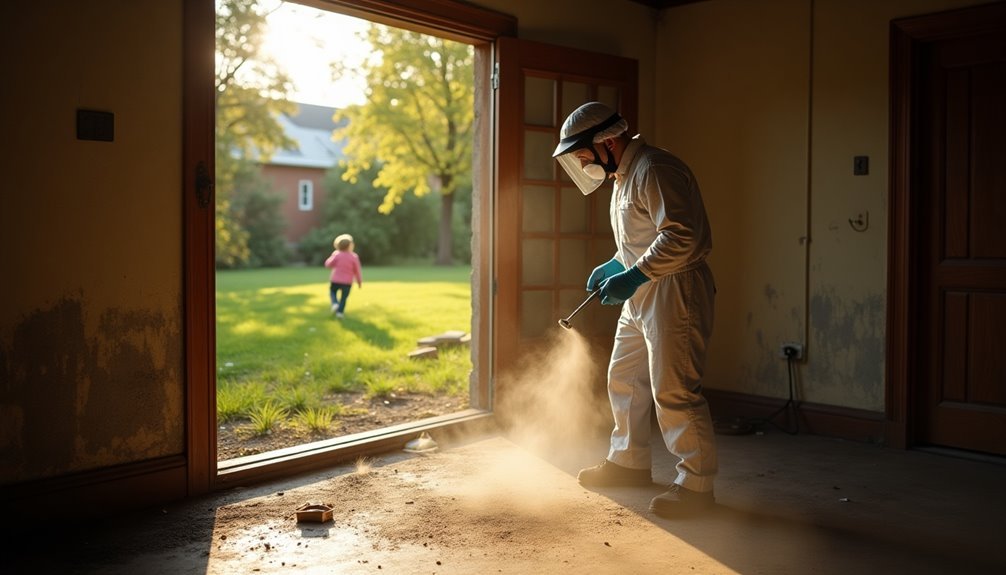Asbestos testing is crucial for protecting your family from hidden dangers that can cause severe health issues. These toxic fibers often lurk in older homes, making early detection essential to avoid risks related to asbestosis and lung cancer. By hiring certified professionals, you can ensure thorough inspections using advanced techniques. This proactive approach not only identifies potential hazards but also helps you navigate legal and financial implications. Understanding asbestos risks empowers you to make informed decisions about necessary remediation. As you explore further, you'll discover specific steps to enhance your home's safety and compliance.
Importance of Asbestos Testing

When it comes to ensuring the safety of your home or workplace, understanding the importance of asbestos testing cannot be overstated. Asbestos regulations are in place for a reason: they protect you, your loved ones, and workers from the serious health risks associated with asbestos exposure. By identifying asbestos in building materials, you can implement effective management and removal strategies to prevent long-term health issues like asbestosis and lung cancer. Additionally, there is no safe level of exposure established, which underscores the necessity for rigorous testing and regulation.
Public awareness of asbestos hazards is vital, especially in older buildings constructed before the 1980s. Mandatory testing before renovations or demolitions not only ensures compliance with legal requirements but also mitigates potential legal and financial consequences. Regular environmental monitoring is essential, too; it helps assess contamination levels and guides necessary remediation efforts.
Asbestos testing is a proactive measure to safeguard your living and working environments. It involves thorough inspections and laboratory analysis, providing you with a detailed report on any asbestos found. This knowledge empowers you to make informed decisions about whether to encapsulate or remove the material entirely, ensuring a safer environment for everyone involved. Ultimately, understanding and acting on the importance of asbestos testing can liberate you from hidden dangers.
Identifying Signs of Asbestos
Identifying signs of asbestos in your home or workplace is crucial for safeguarding your health and that of your loved ones. Asbestos-containing materials aren't identifiable by sight alone unless they're labeled. Common areas to check include older homes, shipbuilding yards, and construction sites. Materials like drywall, insulation, and electrical fuse boxes may harbor asbestos.
To assist in your identification efforts, consider the following table:
| Visual Inspection Techniques | Signs of Wear or Damage |
|---|---|
| Look for tears or abrasions | Check for water damage |
| Inspect areas for extreme vibration | Monitor for dust or debris |
| Observe airflow patterns | Limit access to damaged areas |
Using proper asbestos identification methods is essential. A trained and accredited asbestos professional can provide accurate assessments. Remember, even minor damage can release asbestos fibers, posing serious health risks. Additionally, asbestos-related diseases can take decades to develop, making early detection and prevention even more critical. Avoid disturbing materials during remodeling or repairs, as this could exacerbate the situation. If you suspect asbestos, maintain a safe distance and consult an expert for further evaluation. Taking these precautions can help ensure a safer environment for you and your family.
Asbestos Testing Process

Once you've identified potential asbestos-containing materials, the next step is to undergo the asbestos testing process. This involves sample collection, where a certified inspector carefully takes samples from various "hot spots" in your property, such as insulation, floor tiles, and popcorn ceilings. To minimize disruption and exposure, sampling is generally conducted when the building is least occupied.
Once collected, these samples are sent to a certified laboratory for lab analysis. The primary method used is Polarized Light Microscopy (PLM), which identifies asbestos in bulk materials. For air samples or fine particulates, Transmission Electron Microscopy (TEM) offers higher magnification, while Phase Contrast Microscopy (PCM) serves as an initial screening tool for air monitoring.
The laboratory provides a comprehensive report detailing the areas tested, types of asbestos found, and their percentage composition. This report is crucial in determining whether the asbestos should be left undisturbed, encapsulated, or removed. By understanding this testing process, you empower yourself to make informed decisions about your family's safety and the necessary steps to mitigate the risks associated with asbestos exposure.
Advantages of Professional Inspectors
When it comes to asbestos identification, professional inspectors bring a level of expertise that ensures hidden dangers are uncovered. Their thorough testing processes not only pinpoint asbestos-containing materials but also prioritize safety, minimizing the risk of exposure during inspections. By relying on trained professionals, you're taking a critical step in protecting your family's health and well-being.
Expertise in Asbestos Identification
Having a professional inspector assess your property for asbestos is crucial for ensuring the safety of your family. These experts possess the necessary inspector qualifications, including specific training and certifications mandated by asbestos regulations. For instance, certifications like the Asbestos Investigator Certification from the New York State Department of Labor ensure that inspectors have the required knowledge and experience, typically involving two years of documented work in building surveys.
Utilizing advanced technologies, professional inspectors can conduct precise and thorough assessments. They employ specialized equipment to detect asbestos-containing materials (ACMs), significantly reducing the risk of overlooking potential hazards. A comprehensive inspection process includes examining all accessible areas of your property, such as attics and crawl spaces, and collecting samples for laboratory analysis.
Only trained and accredited inspectors can accurately identify ACMs through lab testing, ensuring that the identification process goes beyond mere visual inspections. The detailed report they provide outlines the location and extent of asbestos, along with recommendations for safe removal. This level of expertise not only protects occupants but also informs removal teams on where to focus their efforts, facilitating effective and safe remediation.
Safety During Testing Process
Professional inspectors not only identify asbestos but also implement strict safety measures during the testing process, safeguarding both themselves and your family. They follow rigorous testing protocols to isolate the area, minimizing the risk of asbestos fiber spread. By cutting off ventilation and sealing vents, they prevent contamination of other spaces in your home. The area is enclosed with plastic sheeting, ensuring no unauthorized access during testing.
Inspectors wear appropriate personal protective equipment (PPE), including disposable coveralls, respirators, and nitrile gloves designed to block asbestos fibers. This commitment to protective measures is crucial for their safety and yours. When collecting samples, they wet the materials to reduce fiber release and utilize specialized tools to minimize disturbance.
After sampling, inspectors conduct a thorough cleanup, employing decontamination procedures to ensure no fibers remain. They dispose of all materials according to safety guidelines and verify the area's safety before allowing anyone to re-enter. By choosing professional inspectors, you gain peace of mind, knowing that every step of the testing process prioritizes safety and effectively protects your family from the hidden dangers of asbestos exposure.
Legal and Financial Risks

Ignoring asbestos testing can expose you to significant legal liabilities and costly lawsuits from affected parties. These lawsuits often seek compensation for medical expenses and damages, which can strain your financial resources and impact property value. Additionally, a history of negligence in asbestos management can tarnish your reputation, making future transactions or business dealings more challenging.
Liability and Lawsuits
When it comes to asbestos testing, understanding the legal and financial risks associated with liability and lawsuits is crucial for property owners. Failing to address asbestos issues can expose you to significant legal repercussions and liability exposure. Here are some key points to consider:
- Non-compliance with regulations can lead to fines up to $25,000 per day.
- Lawsuits from workers or neighbors exposed to asbestos can result in costly settlements.
- Compensation claims for asbestos-related illnesses can exceed millions in settlements.
- Civil litigation can tarnish your business image and trust within the community.
- Regulatory bodies enforce strict penalties for improper handling and disposal of asbestos.
Property Value Impact
The presence of asbestos in a property not only poses legal and financial risks but also significantly impacts its market value. Homes with identified asbestos typically sell for 5-15% less than comparable asbestos-free properties. This reduction in property valuation can vary based on the extent and location of asbestos within your home. If asbestos is found in critical structural components, the impact on market perception can be even more severe.
Buyers often see properties with asbestos as high-risk investments, leading to reduced offers or even withdrawal from negotiations. This stigma can make selling your home more challenging, with potential buyers demanding significant discounts or professional removal before closing the deal. In fact, some might walk away entirely due to fears about long-term health consequences, making asbestos a deal-breaker that can drastically lower your asking price.
Furthermore, the costs associated with asbestos removal can reach thousands of pounds, further diminishing your property's value. Elevated insurance premiums and potential exclusions from standard policies can add to your financial burden, making it crucial to address asbestos concerns proactively to protect both your family and your investment.
Actions After Testing
After receiving your asbestos test results, it's crucial to act based on what those findings reveal. If no asbestos or levels within acceptable safety limits are present, you don't need to take further steps. However, if asbestos is detected, you must consider your options for asbestos management and remediation.
Here are some actions to consider:
- Assess the Condition: Review whether the asbestos is in good condition or damaged.
- Plan for Abatement: If necessary, create a detailed asbestos abatement plan.
- Hire a Professional: Select a licensed and certified contractor with strong reviews.
- Choose Remediation Options: Decide between removal, encapsulation, or limiting access based on professional evaluation.
- Post-Remediation Checks: Ensure thorough cleanup and air monitoring after any remediation work.
Taking the right actions ensures your family's safety and mitigates the risks associated with asbestos exposure. By understanding your options and making informed decisions, you empower yourself to protect your home and loved ones from hidden dangers.
Long-Term Health Considerations

Asbestos exposure poses serious long-term health risks that can linger for decades, often surfacing long after the initial contact. You may not see the effects immediately; diseases like asbestosis or lung cancer can take 15 years or more to develop, while rare conditions such as mesothelioma might not appear until 30 to 50 years post-exposure. These asbestos diseases significantly increase your cancer risks, impacting not only your lungs but potentially leading to digestive system cancers as well.
The cumulative nature of asbestos exposure means that even small amounts can be dangerous, particularly for those who've spent years in environments with asbestos. If you or a loved one has worked with or around asbestos, the threat of serious health issues isn't just a concern—it's a reality. It's vital to understand that no level of asbestos is truly safe, and smoking in conjunction with asbestos exposure amplifies these risks dramatically.
Regular monitoring and testing can help mitigate these hidden dangers. By taking proactive steps, you can safeguard your family's health against the insidious effects of asbestos-related diseases.
Conclusion
By investing in asbestos testing, you're not just protecting your family; you're safeguarding their future. Think of your home as a ship navigating stormy seas—hidden asbestos can be like unseen holes in the hull, slowly compromising safety. A thorough inspection can identify those vulnerabilities before they lead to disaster. Remember, knowledge is your anchor; it keeps you steady against the hidden dangers that could jeopardize your loved ones' health. Don't wait—take action today for peace of mind.
